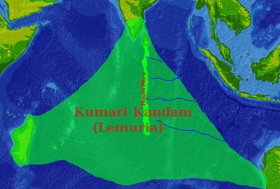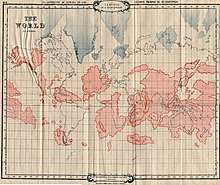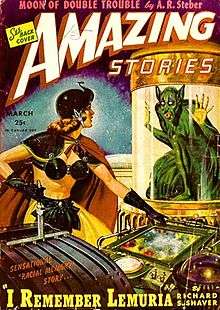Lemuria in popular culture
Lemuria is the name of a hypothetical "lost land" variously located in the Indian and Pacific Oceans. It is said in Tamil legend to have been civilised for over 20,000 years, with its population speaking Tamil. The concept of Lemuria has been rendered obsolete by modern understanding of plate tectonics. However, it has still been used as a location and inspiration in a wide range of novels, television shows, films and music.

Blavatsky, Elliot and Bramwell

"Lemuria" entered the lexicon of the occult through the works of Helena Blavatsky, who claimed that the Mahatmas had shown her an ancient, pre-Atlantean Book of Dzyan. Lemuria is mentioned in one of the 1882 Mahatma Letters to A. P. Sinnett.[1] According to L. Sprague de Camp, Blavatsky's concept of Lemuria was influenced by other contemporaneous writers on the theme of lost continents, notably Ignatius L. Donnelly, American cult leader Thomas Lake Harris and the French writer Louis Jacolliot.[2]
Within Blavatsky's complex cosmology, which includes seven "Root Races", the "Third Root Race" occupied Lemuria. She describes them as about 7 feet (2.1 m) tall, sexually hermaphroditic, egg-laying, mentally undeveloped and spiritually more pure than the following "Root Races". Before the coming of the Lemurians, the second "Root Race" is said to have dwelled in Hyperborea. After the subsequent creation of mammals, Mme Blavatsky revealed to her readers, some Lemurians turned to bestiality.
The later theosophical author William Scott-Elliot gave one of the most elaborate accounts of lost continents. The English theosophist received his knowledge from Charles Webster Leadbeater, who reportedly communicated with the Theosophical Masters by "astral clairvoyance".[3] In 1896 he published The Story of Atlantis, followed in 1904 by The Lost Lemuria, in which he included a map of the continent of Lemuria as stretching from the east coast of Africa across the Indian and the Pacific Oceans.[4]
James Bramwell portrayed Lemuria in his book, Lost Atlantis, as "a continent that occupied a large part of what is now the South Pacific Ocean".[5] He described the people of Lemuria in detail and characterized them as one of the "root-races of humanity". According to Bramwell, Lemurians are the ancestors of the Atlanteans, who survived the period "of the general racial decadence which affected the Lemurians in the last stages of their evolution". From "a select division of" the Atlanteans – after their promotion to decadence – Bramwell claims the Aryan race arose. "Lemurians, Atlanteans, and Aryans are root-races of humanity", according to Bramwell.[6]
Australia
Blavatsky theorised that Australia was a remnant inland region of Lemuria and that Aboriginal Australians and Aboriginal Tasmanians (which she identified as separate groups) were of Lemurian and Lemuro-Atlantean origin, after cross-breeding with animals. Her idea was subsequently developed in pseudo-histories and fiction of the white Australian popular culture of the 1890s and early 1900s, including the writings of nationalist Australian poet Bernard O'Dowd, author Rosa Campbell Praed in My Australian Girlhood, author John David Hennessey in An Australian Bush Track and George Firth Scott's novel The Last Lemurian: A Westralian Romance.[7][8]
Professor Robert Dixon theorises that the popularity of the idea of "lost races" like Lemurians and Atlanteans reflected the anxieties of colonial Australians, that "when Englishness is lost there is nothing to replace it".[7] A. L. McCann attributes Praed's use of the Lemuria trope to an "attempt to create a lineage for white settlers without having to confront the annihilation of Indigenous people" (which Praed's father was involved in).[9]
Mount Shasta
In 1894, Frederick Spencer Oliver published A Dweller on Two Planets, which claimed that survivors from a sunken continent called Lemuria were living in or on Mount Shasta in northern California. Oliver claimed the Lemurians lived in a complex of tunnels beneath the mountain and occasionally were seen walking the surface dressed in white robes.
In 1931 Harvey Spencer Lewis using the pseudonym Wisar Spenle Cerve[10] wrote a book (published by the Rosicrucians) about the hidden Lemurians of Mount Shasta that a bibliography on Mount Shasta described as "responsible for the legend's widespread popularity."[11] This belief has since been repeated by Guy Warren Ballard and the followers of the Ascended Masters and the Great White Brotherhood, The Bridge to Freedom, The Summit Lighthouse, Church Universal and Triumphant and Kryon.
Kumari Kandam
Some Tamil writers such as Devaneya Pavanar have associated Lemuria with Kumari Kandam, a legendary sunken landmass mentioned in the Tamil literature, claiming that it was the cradle of civilization.
List of notable examples in popular culture
Literature

- George Firth Scott is best known for his novel The Last Lemurian: A Westralian Romance (1898)
- Richard Sharpe Shaver's "I Remember Lemuria" was published in the science fiction magazine Amazing Stories, in the March 1945 issue; related stories were prominently featured over the next four years.[12]
- H. P. Lovecraft mentioned Lemuria as a previous resting place for the Shining Trapezohedron in the Cthulhu Mythos story "The Haunter of the Dark".[13]
- In the Kull stories of Robert E. Howard, Lemuria is a nation of islands inhabited by a race of barbarians.[14] In Howard's Conan tales, Lemuria has been destroyed in a great Cataclysm but the survivors have become the ancestors of the Hyrkanians.[15]
- Two implicit references to Lemuria are found in J.R.R. Tolkien's artwork: 1) In the world map printed in The Shaping of Middle-earth, the continent labelled "Dark Land (South Land)" is implicitly a Lemurian analogue.[16] And in his watercolor illustration of the Earth as seen from the Moon, the (unlabeled) continents of Atlantis and Lemuria are visible.[17]
- In Thomas Pynchon's 2009 novel Inherent Vice, Lemuria is mentioned quite a few times. Being an ephemeral place, it serves as an apt symbol for 1960s California.[18]
- In the Perry Rhodan series, Lemuria was the home continent of the Lemurians (also called the First Humanity) 50,000 years ago.[19]
- In Dougal Dixon's After Man: A Zoology of the Future, the author posits that a portion of eastern Africa will break off from the main continent and become the last refuge of large ungulates, which are outcompeted by "rabbucks" (rabbit descendants) elsewhere in the world, and names the new island "Lemuria".
- In Karel Čapek's 1936 novel War with the Newts, engineers use the eponymous Newts in order to create a new continent, Lemuria, as a part of their many land reclamation projects.[20]
- In Daniel Pinkwater's 1979 novel Alan Mendelsohn, the Boy from Mars, the myth of Lemuria and other lost places is used by travelers from other worlds as a way to refer to their cultures without revealing their origin.[21] Lemuria is also referenced heavily in the plot.[22]
Film
- The Return of Chandu, the 1934 film serial continuation of the 1932 movie Chandu the Magician starring Bela Lugosi, partly takes place on Lemuria.
- In The Lost City, a 1935 film serial, the last survivor of Lemuria seeks to conquer the world.
- The antagonists of the 1973 movie Godzilla vs. Megalon claim to be descendants of the civilization on Lemuria, although they refer to themselves as Seatopia.
- The Golden Voyage of Sinbad The 1973 film's adventures takes place mostly on Lemuria
- Captain America: The Winter Soldier features a ship called "The Lemurian Star". Lemuria is featured in the plotline of the Captain America comics.
Television
- Transformers: Cybertron, in its initial form of Transformers: Galaxy Force, featured Lemuria as the name of a starship.[23]
- In the Japanese television series GoGo Sentai Boukenger, the character Natsuki Mamiya (BoukenYellow) is a survivor of ancient Lemuria.[24]
- In The Secret Saturdays, a main character, Fiskerton, is a Lemurian.[25]
- In Mighty Max, the protagonist's mentor, Virgil, and his nemesis, the Skull Master, are the last survivors of Lemuria.
- In Ancient Aliens, season 14 episode 12 about Hawaii and contact with ancient astronauts
- In The Deep (2015 TV series), the protagonists Nekton family has a long history of searching for "the lost city of Lemuria", which becomes a major plot arch in seasons 2 and 3.
Games
- The video game Radia Senki: Reimeihen takes place in a world called Lemuria.
- In the video game Wurm: Journey to the Center of the Earth, the antagonistic underground faction known as the Nonmaltas are descendants of Lemuria, their humanoid rivals the Dinamur are descendants of Atlantis, while modern surface-dwelling humans are descendants of Mu.
- In the video game Golden Sun series, Lemuria is a major plot point. In the first title, locating Lemuria is the motivation behind the construction of Babi's Lighthouse by Lord Babi, who had previously shipwrecked on the island and obtained a supply of water from the fountain of youth there. In the sequel, Golden Sun: The Lost Age, the party member and Water Adept Piers is a Lemurian, and much of the game is spent figuring out how to navigate through the Sea of Time, where Lemuria is located, and defeat its guardian, Poseidon.
- In the visual novel Ever 17, the primary setting is an underwater theme park called LeMU, which is entirely themed around Lemurian ruins.
- In the video game Nostalgia, one of the many secret dungeons included in the game is the "Dungeon of Lemuria".
- The video game Kinectimals, takes place on an island named "Lemuria" populated mainly by lemurs and felines.
- In the video game Final Fantasy XI, a supernatural region known as Lumoria (commonly referred to as "Sea" by players) is introduced in the expansion Chains of Promathia towards the end of the main storyline.
- The video game Final Fantasy XII: Revenant Wings, the main part of the story centers around the discovery of Lemurés, a floating continent above Ivalice that was shielded from the rest of the world by the god Feolthanos.
- In Genius: the Transgression, a fan-made expansion of the tabletop role-playing game New World of Darkness, Lemuria is two things: 1) a "Bardo" (a scientifically-obsolete theoretical place that manifests when disproved) that appeared when the theory of plate tectonics became accepted as fact; or 2) an ancient organization of Geniuses who controlled the course of human development (led by the time-traveling former inhabitants of said Bardo), whose control began to falter during the Renaissance and ended in World War II.
- In the trading card game Yu-Gi-Oh!, there is a card known as "Lemuria, the Forgotten City".
- The video game Child of Light takes place in a mystical world known as Lemuria.
- In the video game Risk of Rain, which takes place on a mysterious, fictional planet, enemies are called Lemurians.
- In the online game Fate/Grand Order, the Noble Phantasm Chant of Helena Blavatsky contains Lemuria's name as "Lemuria in the sea"
- The Commodore 16 game Lemuria published by Atari takes place there.
- The MMORPG Champions Online features an underwater zone called Lemuria.
Music
- The eleventh full-length album released in 2004 by Swedish symphonic metal band Therion is titled Lemuria.
- Symphonic black metal band Bal-Sagoth has an album named A Black Moon Broods over Lemuria which features Lemuria.
- The band Visions of Atlantis has a song on their second CD Cast Away titled "Lemuria".[26]
- Visions of Atlantis has a song on their sixth album "The Deep & The Dark" titled "Return to Lemuria".[27]
- Electronic musician Lone has an album called Lemurian.
- American band Sun City Girls feature a song called "The Fine-Tuned Machines of Lemuria" on the You're Never Alone With a Cigarette 7" single.[28]
- Alternative rock artist Black Francis explained that his song "Velouria" is about a Lemurian girl living in Mount Shasta who "was covered in fur".[29]
- Italian black epic metal band Stormlord (band) released a song titled "Memories of Lemuria" on their 2005 album The Gorgon Cult.
- Australian electronic band Midnight Juggernauts released a song simply titled "Lemuria" on their 2010 album The Crystal Axis.
- The 2015 album The Ancient & Arcane by American EDM artist Varien contains a song titled "Transmissions from Lemuria".[30]
- Lemuria, The Lost Continent is a 20-minute composition for two cellos, percussion and cello choir commissioned by the Left Coast Ensemble written by composer Clarice Assad[31]
- The second track of the 1969 Atlantis album by American jazz composer Sun Ra is titled "Lemuria".
- The eighth track on the 2000 album "In Name and Blood" by The Murder City Devils, released through SubPop, is entitled "Lemuria Rising"
Comics
- In Marvel Comics, there are two fictional nations that both use the name Lemuria. One is the underwater home of Princess Llyra, an antagonist to Namor the Sub-Mariner of Atlantis, while the other is the underground homeland of the superhuman Deviant race.[32]
- In DC Comics, the Lemurians are a scaly race of humanoids living below the sea. (Super-Team Family #13-14)
- In the Saint Seiya canon, there are three Lemurians that apparently survived the disappearance of the continent: Shion, Mu and Kiki. The three of them possess extremely powerful telekinetic powers. In Saint Seiya Omega, there is one more: Raki, Kiki's apprentice.
- At one point, the protagonist of Dresden Codak wonders why Lemuria is missing from a wall-size map of the world.[33]
- In the HYbrid x Hybrid Magias Academy Ataraxia series, Lemuria is the name of the world where the main characters lives.
Footnotes
- The Mahatma Letters, XXIIIb
- Sprague de Camp, L. (1970). Lost Continents: The Atlantis Theme in History, Science, and Literature. Dover Publications. p. 58.
Madame Blavatsky's lost-continent doctrine seems to be based largely on the works of Donnelly, Harris and Jacolliot
- See also Man: whence, how and whither, a record of clairvoyant investigation#In Lemuria
- The Lost Lemuria, at Sacred Texts.com
- Bramwell, James. Lost Atlantis. (Hollywood: Newcastle, 1974), 193.
- Bramwell, 195.
- Bongiorno, Frank (2000). "Aboriginality and historical consciousness: Bernard O'Dowd and the creation of an Australian national imaginary" (PDF). Aboriginal History. 24: 39–58 – via ANU Press.
- "The Lost Lands of Mu and Lemuria: Was Australia Once Part of a Sunken Continent? – New Dawn : The World's Most Unusual Magazine". Retrieved 2019-01-07.
- "Stargazing with Rosa Praed". Sydney Review of Books. 2016-10-31. Retrieved 2019-01-07.
- Melton, J. Gordon (Mar 1999). Religious leaders of America: a biographical guide to founders and leaders of religious bodies, churches, and spiritual groups in North America (2nd ed.). Cengage Gale. p. 332. ISBN 978-0810388789.
- Meisse, William C. (1993). Mount Shasta: an annotated bibliography. College of the Siskiyous. p. 146.
- The cover of I Remember Lemuria is featured in an article "Warum Aliens nicht grün sein müssen" (in German) (Why Aliens don't have to be green) at Telepolis.
- Lovecraft, H.P. The Haunter of the Dark.
It was treasured and placed in its curious box by the crinoid things of Antarctica, salvaged from their ruins by the serpent-men of Valusia, and peered at aeons later in Lemuria by the first human beings.
- Howard, Robert E. (2006). Kull: Exile of Atlantis. Del Rey Books. ISBN 0-345-49017-7.
- Howard, Robert E. (2003). "The Hyborian Age" essay in The Coming of Conan the Cimmerian. Del Rey Books. ISBN 978-0345461513.
- https://i.stack.imgur.com/tIkcH.jpg
- https://sites.google.com/site/endorenya/anthroposophy-and-the-middle-earth-legendarium/globe%20with%20lemuria%20and%20atlantis.png
- Thomas Pynchon, Inherent Vice, 1st Paperback Edition (New York: Penguin Books, 2010), 101, et seq.
- "Lemur" (in German). Pr-materiequelle.de. Archived from the original on 2011-07-19. Retrieved 2010-01-14.
- Čapek, Karel (1985). War with the Newts. Evanston, IL: Northwestern University Press. p. 189. ISBN 0810106639.
- Pinkwater, Daniel M. (1980). Alan Mendelsohn, the boy from Mars (2. [pr.]. ed.). New York: Dutton. p. 27. ISBN 0-525-25360-2.
- Alan Mendelsohn, the boy from Mars, p. 17 et. seq
- https://tubitv.com/tv-shows/110944/s02_e19_optimus
- http://supersentai.com/database/2006_boukenger/rg-natsuki.htm
- https://itunes.apple.com/ca/tv-season/the-secret-saturdays-season-2/id311954835?l=fr
- "Visions of Atlantis -- Lemuria -- Listening & Stats at Last.fm".
- "Metal Archives -- Visions of Atlantis -- The Deep & The Dark".
- "Discography - You're Never Alone with a Cigarette (1990)". Sun City Girls. Retrieved 2014-08-05.
- "Black Francis - Velouria (Live at 89.3 The Current) on YouTube".
- "Varien's 'The Ancient & Arcane' is a cinematic masterpiece". Dancing Astronaut. 10 August 2015. Retrieved 16 September 2018.
- "The Sounds of Nature' explores the Lemurian connection". leftcoastensemble.org. 19 November 2018. Retrieved 19 November 2018.
- Elliot R. Brown (a). "Lemuria" (Deluxe edition) The Official Handbook of the Marvel Universe 7: 26 (1985), Marvel, retrieved on 5 August 2014
- "Archive » Dark Science #22 - Caspar". Dresden Codak. 2012-11-03. Retrieved 2014-08-05.